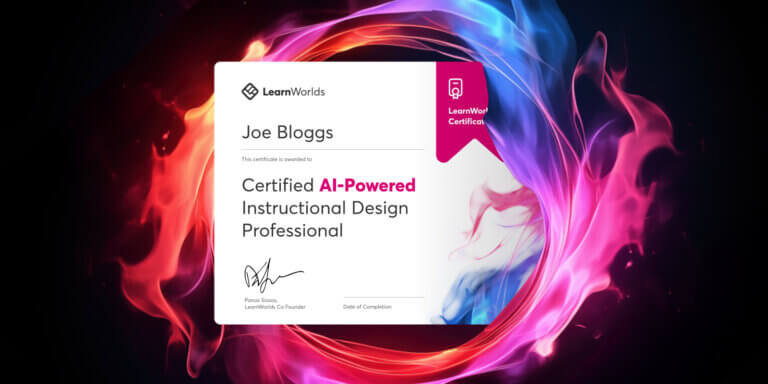Table of Contents
The field of instructional design is evolving rapidly, with Artificial Intelligence (AI) at the forefront of this transformation. For course creators, AI isn’t just a buzzword—it’s a game-changing tool that streamlines content creation, enhances learner engagement, and offers personalized learning experiences.
The AI & Instructional Design Certification Workshop gives you hands-on experience with AI tools, guiding you in integrating AI seamlessly into your instructional design process.
If you’re eager to dive right in and skip the reading, click the link below to join the workshop for FREE and start your journey towards certification!
If you’re looking for the inside scoop, the real essence of it all, this blog post will dive into the practical benefits AI brings to instructional designers, drawing insights from the workshop.
We will cover AI’s role in course planning, content creation, assessment design, and feedback generation, while highlighting the unique advantages of AI for course creators.

Understanding the 5 Layers Framework for AI in Instructional Design
In the AI & Instructional Design Certification Workshop we introduce a structured approach called the 5 Layers Framework. This framework helps you understand and implement AI at every stage of the instructional design process.
Let’s explore each of these five layers:
Layer 1: Understanding the Topic
The first layer focuses on using AI to understand your subject area deeply. Whether you are an expert in your domain or new to a particular topic, AI acts as your assistant to help you explore and clarify key concepts, terminology, and trends.
You can use AI to generate domain-specific insights, answer questions, and even suggest content ideas that are tailored to the topic at hand.
Layer 2: Producing Learning Activities
In the second layer, AI assists in producing rich learning activities for your courses. From flashcards and timelines to fill-in-the-blank worksheets and self-assessment checklists, AI can generate a variety of educational artifacts that cater to different learning styles.
These activities help ensure that your learners stay engaged and that the content remains interactive and relevant.
Layer 3: Being Efficient with Prompt Engineering
The third layer emphasizes efficiency through prompt engineering. Crafting precise prompts can significantly enhance the output quality when using AI.
This layer teaches you how to formulate prompts strategically to get the most detailed and useful responses, ensuring that the generated content meets your specific educational needs.
Whether it’s creating a presentation, a blog post, or a complex course outline, mastering prompt engineering helps you work smarter, not harder.
Layer 4: Building Exceptional Instructional Plans
Layer four is all about instructional design—using AI to build theory-driven, exceptional instructional plans. AI helps integrate well-known frameworks like Bloom’s Taxonomy, Gagné’s Nine Events of Instruction, and the ADDIE model into your course design.
This ensures that your course has a solid pedagogical foundation and that learning objectives are aligned with cognitive development goals.
AI makes it easy to incorporate these educational theories into your design, saving time while maintaining quality.
Layer 5: Enhancing Content and Communication
The fifth and final layer focuses on using AI to enhance all aspects of content and communication. This layer includes functions like the Course Planner, Ebook Writer, Content Editor, Assessment Designer, Email Creator, and Feedback Generator.
These integrated AI methods help automate and improve content creation, assessment generation, learner communication, and personalized feedback.
This layer aims to make the course creation process as seamless and efficient as possible, allowing you to focus more on teaching and less on administrative tasks.
By understanding and applying these five layers, course creators can leverage AI to make the instructional design process more efficient, effective, and engaging.
Whether you’re creating a course outline, drafting learning materials, designing assessments, or providing feedback, the 5 Layers Framework helps ensure that AI is seamlessly integrated into every step of the process.
Why AI is Crucial for Instructional Design
AI has become a vital tool for instructional designers, offering solutions that save time, reduce manual tasks, and create dynamic learning experiences.
Here’s how AI can transform your instructional design process:
Let’s dive deeper into these benefits and how the AI & Instructional Design Certification Workshop equips you to harness these capabilities.
Course Planning Made Easy: AI as Your Co-Planner
One of the most time-consuming aspects of course creation is planning the structure. What should go into each section? How many activities should each module include? This is where AI steps in as your assistant.
With the AI-powered Course Planner, you can streamline this process by setting simple parameters like instructional models (e.g., Gagné’s Nine Events of Instruction or Kolb’s Experiential Learning Theory), activity types (e.g., videos, eBooks), and course levels (introductory, advanced, etc.).
AI then generates a detailed course outline, complete with activities and sections—all while maintaining flexibility for edits and customization.
This not only cuts down on planning time but also ensures your course structure aligns with pedagogical best practices—giving you more time to focus on delivering exceptional content.
💁 Here’s an example:
With the AI-powered Course Planner, you can easily create a course on instructional design models. By specifying that you want an introductory course with two sections and three activities per section, AI generates a course outline featuring an introduction to instructional design models, followed by their applications.
The generated activities are tailored to the course level, making it easy for you to customize as needed.
Creating Content at Scale
It’s no secret that one of the biggest challenges for most course creators is consistently producing high-quality content.
Well, the AI & Instructional Design Certification Workshop shows how AI can help you generate learning materials, including text-based content, quizzes, and eBooks, that match the tone, style, and complexity you need.
With the AI-powered Ebook Writer, creating entire chapters, case studies, or even creative stories is just a few clicks away.
By defining the desired structure and tone, AI generates full ebook sections, including storytelling elements complete with characters and settings.
Imagine the time saved when AI helps you draft an engaging chapter on instructional design models in seconds, allowing you to focus on fine-tuning the content rather than starting from scratch.
💁 Here’s an example:
The Ebook Writer can create a full chapter on different instructional design models, including the ADDIE model, Gagné’s Nine Events of Instruction, and Merrill’s Principles of Instruction.
You can set the tone to be attention-grabbing, making the content more engaging for novice learners.
This way, you can quickly generate structured content while maintaining control over its quality and presentation.
Automating Assessment Design
Assessments are crucial for evaluating learner progress, but creating them manually can be time-consuming. AI simplifies this process by generating customized assessments tailored to your course material.
The integrated Assessment Designer allows you to create diverse types of questions—from multiple-choice to true/false to fill-in-the-blank.
💡Interested in the best types of assessments for online learning? We’ve got you covered in this article: What Are The Best Types of Assessments for Online Learning?
You can even specify the difficulty level or tie questions to an instructional theory like Bloom’s Taxonomy. AI generates both the questions and the feedback for correct or incorrect answers, providing immediate, contextual insights for learners.
This feature not only saves time but also ensures high-quality, pedagogically sound assessments that are crucial for effective learning.
💁 Here’s an example:
Using the Assessment Designer, you can generate multiple-choice questions based on Bloom’s Taxonomy for a course on effective learning strategies.
AI will create questions at various cognitive levels—such as knowledge, comprehension, and application—along with detailed feedback for each answer.
This ensures that learners receive meaningful insights into their progress, making the assessment process both efficient and impactful.
Feedback Generation at Scale
Providing detailed feedback is one of the most challenging tasks for instructors, especially when handling a large group of learners. AI makes this process significantly more efficient.
The Feedback Generator tool allows you to provide personalized feedback by analyzing a student’s response and adjusting for tone, detail, and level of support.
Whether you need supportive, balanced, or rigorous feedback, AI can generate suggestions based on these parameters, allowing you to maintain consistent and thoughtful feedback across all your learners, without the manual workload.
💁 Here’s an example:
The Feedback Generator can be used to provide balanced and encouraging feedback for an open-ended assignment on instructional design.
By defining the feedback as “supportive” and “enthusiastic,” AI generates comments that highlight the learner’s strengths while offering suggestions for improvement, making the feedback both personalized and constructive.
Engaging Your Audience with AI-Generated Emails
Effective communication is key to maintaining learner engagement, and AI can assist here as well. The Email Creator helps you generate emails for course updates, announcements, or live session invitations.
For instance, if you want to promote a new course or event, you can set parameters like the goal of the email, tone (e.g., inviting), and call to action.
AI generates a personalized and engaging email draft, which you can easily customize to resonate with your audience.
This helps you save hours otherwise spent writing and formatting emails while ensuring the messaging is consistent and professional.
💁 Here’s an example:
The Email Creator can help draft an inviting email for a new live session.
By setting the tone to be enthusiastic and including a clear call to action like “Join us for an exciting learning experience,” AI crafts an engaging email that encourages learners to participate, making your communication both effective and efficient.
Enhancing Content with the AI Content Editor
Content creation doesn’t stop once you’ve written your material. Often, the text needs refining to better suit your tone, style, or brand voice. The Content Editor is designed to polish your content, offering options to rewrite, expand, or make your text more engaging.
Whether you need to make a course description more humorous or more formal, or if you want to rephrase content to make it more impactful, AI provides these functions at your fingertips.
By offering options like “polish,” “expand,” or “rewrite,” the Content Editor ensures that your writing is clear, concise, and engaging, freeing up more of your time to focus on other aspects of course creation.
💁 Here’s an example:
The Content Editor can take a straightforward course description and make it more humorous to better connect with your audience.
For example, changing “This course covers the basics of instructional design” to “Get ready to dive into the exciting world of instructional design—no boring lectures here!” helps make the content more relatable and engaging.
Thinking Outside the Box with Creative Techniques
AI is not just a tool for automation; it’s also a creativity booster through techniques like analogies, role-play, and humor.
For instance, you can use AI to explain complex concepts in simple, relatable ways.
💁 Here’s an example:
An example is using an analogy from cooking to explain market segmentation: “Imagine you are a chef preparing a grand feast—you need to segment your guests into groups based on their preferences.”
This analogy makes the abstract concept of market segmentation more tangible and relatable to learners. AI can also generate engaging role-play activities, such as explaining active listening in the style of Jack Sparrow, making the learning experience more entertaining and memorable.
When teaching the concept of active listening, you can use AI to create a role-play scenario where Jack Sparrow explains it in his unique, humorous style. This approach not only makes the learning fun but also helps learners remember the concept better due to its engaging delivery.
AI Promotes Critical Thinking and Human Oversight
While AI is a powerful tool for streamlining course creation, it’s crucial to remember that it works best when paired with human oversight.
As noted in the workshop’s community, “AI can often produce hallucinations, and we should be encouraging people to do their due diligence to ensure the content is correct.”
AI may generate content quickly, but verifying that information is accurate and contextually appropriate is a critical part of the process.
Another community member who has already participated in the workshop highlighted this balance well: “AI is your writing partner, not your replacement. Don’t publish anything you haven’t checked/edited.” AI offers a fantastic first draft, but it’s the instructional designer’s job to ensure that the content is correct and aligned with course objectives.
By encouraging human oversight, AI also promotes critical thinking. A community member suggested that AI, when used effectively, can actually foster critical thinking by requiring instructional designers to refine and customize the generated content, ensuring it aligns with their voice and educational goals.
AI: Your Creative Partner in Transforming Instructional Design
The AI & Instructional Design Certification Workshop is designed to help you master the use of AI in every step of course creation.
From planning and content development to assessments and learner communication, AI acts as a powerful co-creator that reduces manual effort, improves efficiency, and enhances the learning experience.
With AI as your partner, you can focus more on delivering exceptional learning outcomes while the technology takes care of the heavy lifting.
Ready to take your instructional design skills to the next level?
Enroll in the AI & Instructional Design Certification Workshop today and start revolutionizing the way you create, deliver, and manage your courses. Join a growing community of instructional designers who are using AI to transform education.
Rosemary is LearnWorlds’ Content Marketing Manager. She has over 2 decades of experience in omnichannel marketing and content writing for the IT and SaaS industry. Her expertise lies in crafting effective content marketing strategies that attract, engage, and nurture customers, enabling LearnWorlds to reach its target audiences with precision.


